Regarding linear frequency response... anyone producing a perfect linear loudspeaker and the consumers shopping for perfectly linear loudspeaker isn't seeing the big picture
Absolutely right, 99% here in the forum will probably agree - only the on-axis measurement of a loudspeaker says almost nothing.
Otherwise there would have been no need for a CTA-2034-A standard and we would continue to measure only on-axis as we did 40 years ago.
A reasonably linear on-axis frequency response is not a sufficient condition for a good loudspeaker, but in most cases it is a necessary one.
I was manufacturing linear speakers 30 years ago - it's easy... anyone can do it. Flat frequency response is a naturally intuitive path for speaker designers and reviewers but it's it's not what a highly enlightened or well-informed acoustical physicist is going to ultimately end up with.
Yep, a speaker designer will take into account the entire radiation of a speaker (of course also aspects such as max SPL, distortion, compression,...).
This is where CTA-2034-A comes in handy for the consumer, as it makes it easier to judge the quality of a speaker design based on a few curves such as on-axis FR, LW, ER, SP, DI, ERDI and PIR, but also, for example, how well a speaker reacts to EQ.
There is no one perfect curve (on-axis FR, LW, ER, SP, DI, ERDI and PIR all matters). But for a good speaker design, all of these curves will be smooth, ideally without abrupt humps or dips.
The sound reflected from the room walls should match the sound of the direct sound - so e.g. look at the early reflections and ERDI.
The overall sound characteristic of a speaker in the listening room should be balanced; certain frequency ranges should not stand out - so e.g. have a look at sound power and SPDI... etc.
Even most amateur speaker designers have been proceeding in this manner for a decade or two. The CTA-2034-A standard facilitates such considerations and sensibly expands them with detailed considerations such as "side wall bounce" curve, predicted In-room response ... etc.
Let's now consider, for example, a speaker like the
Tekton Moab or
Encore Monitor from these perspectives, specifically focusing on the high-midrange units of these speakers:
 Source: Tekton Moab
Source: Tekton Moab
Unfortunately, the manufacturer does not provide complete measurements for these speakers, and the specifications do not include information on crossover frequencies and filter order, which is standard in the studio monitor domain.
There are some
measurements of the Moab by Stereophile, but unfortunately, they were unable to conduct horizontal measurements >45°, and vertically, there were only measurements at +10°, -20°.

 Source: Moab by Stereophile
Source: Moab by Stereophile
However, these measurements already show that the "circular midrange array" leads to horizontal discontinuities. Vertically, this effect is even more pronounced, as the M-T-M arrangement corresponds to the distance ratios of a 12'' woofer with a 1'' tweeter.
Some dips or cancellations are not inherently problematic; they can be intentionally utilized in speaker designs. What matters is the overall concept - so have a look at that.
Since there are no complete measurements available for the Tekton Moab or Encore, we must, at this point, consider the fundamental concept of such speakers via simulation. For the basic examination of the concept "double circular midrange array" plus tweeter, a highly simplified simulation (only 2D cabinet/baffle) is sufficient (of course a professional speaker designer would naturally use much more complex 3D simulation tools).
Here is the simulation of a speaker (
only the high-midrange units) similar to Moab or Encore (simulated listening distance is 3m):
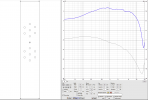
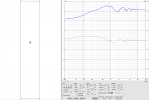
From there, we can simulate complete horizontal and vertical +-180° frequency responses and create a crossover. In this example, a "constant power" filter (Butterworth third order) was used instead of the common "constant voltage" Linkwitz-Riley filter to achieve a slightly more uniform SP, ER, SPDI, and ERDI in the crossover range.
Now the question arise,
has this simulation anything to do with the real speaker?
To be able to assess this, we look the same waterfall plots for the simulation as Stereophile did for the Moab - first on-axis normalized horizontal waterfall +-45°, then on-axis normalized vertical waterfall +-45°


The agreement with the Stereophile measurements is good, horizontally the consequence of the "circular array" beaming is less pronounced than with the real measurements.
So now we can analyze the full behavior of the simulated speaker with "circular tweeter midrange array" similar to Tekton Moab or Encore.
For the horizontal and vertical radiation we look at the normalized hor and ver sonograms (polar maps):
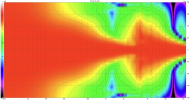
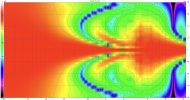
As expected, the 12'' "circular midrange array" narrows the radiation at high frequencies, at the transition to the 1'' tweeter, the radiation abruptly widens because of the wide tweeter radiation.
So the problem with the "circular midrange array" is not primarily inter-driver cancellation, but the very different radiation pattern of the array ("beaming" of the array), which can be compared to a 12'' or 15'' woofer, and the 1'' tweeter.
What does the CTA-2034-A diagram look like for the simulated high-midrange unit similar to a Moab or Encore when a reasonably linear on-axis frequency response is chosen?

In reality, one can mitigate the effects of the very different radiation patterns of midrange and high-frequency units through clever driver selection and crossover design
***. However, the fundamental problem of the concept is likely to persist, as the few Stereophile measurements have already suggested.
So it's likely that direct sound and reflected sound is very different. It's likely that EQ won't work, because flat direct sound will cause unbalanced In-room (reflective) sound and vice versa.
But this is just a small example of how complete measurements and the CTA-2034-A standard are useful for analyzing a speaker design, and that no one in this forum actually values only the on-axis frequency response.
The potential sound of such a speaker concept was deliberately not discussed. If customers perceive such a concept as ideal sounding, that's great for the manufacturer - diversity is not a bad thing.
*** Update:
The horizontal and vertical radiation can be improved if the midrange-tweeter array is divided into two groups. For the tweeters in blue in the array, an early low-pass filter of first or second order is applied. The two tweeters closest to the tweeter, indicated in green, are filtered only at the crossover frequency to the tweeter. As a result, the horizontal and vertical radiation of the midrange array is less focused towards higher frequencies, and the transition to the wide radiation of the tweeter is improved.

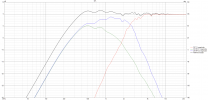


I don't know if Moab or Encore divides the midrange array into groups of tweeters to control directivity. The Encore website hints at something like this. As mentioned before, the information on the website is very sparse.
If the crossover frequency to the tweeter is reduced (simulation uses 2.5kHz), the vertical radiation improves further.














